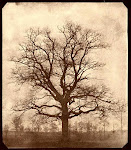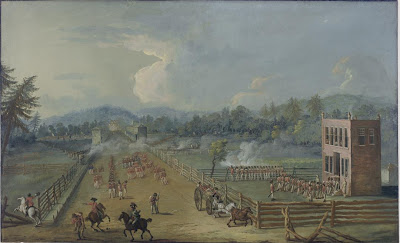~ ~ ~
Monday, October 31, 2011
Friday, October 28, 2011
Follow Friday: Feeling Lucky?
If you feel today is your lucky day in genealogy you should visit SaveThePhotos.
This is a wonderful blog that posts 'rescued' photos along with any notes or research the author can share. As Sharon states regarding her published photos: [these photos are] "Residing in my box with other rescued photos now living again on the Internet, hoping to find their way back home to distant or close relatives."
Thursday, October 27, 2011
The 1794 Massacre of William Casteel's family
Knox County, TN, History; Published 1853
Amongst other acts of Indian hostility perpetrated in Knox county, was one which occurred on the 22nd April 1794. William Casteel lived south of French Broad, about nine miles above Knoxville, and two miles from the then residence of Doctor Cozby. The latter had been an old Indian fighter, from the first settlement of the country, he was, of course, held in deadly hatred by the Indians, and had often been selected as a victim of their vengeance. He had his house always prepared for defense, and never allowed himself to be taken by surprise.
At evening, of the 22nd, his domestic animals gave the usual tokens of the presence of Indians, when, observing from his house, he could discern, obscurely, the stealthy march, in Indian file, of twenty warriors passing across the end of a short lane and concealing themselves in the fence corners and the adjoining woods. The door was at once barricaded, the fire extinguished, two guns primed afresh, and with these he prepared to defend his castle and his family, consisting of his wife and several children, one of whom only could shoot.
A space of more than one hundred yards had been cleared around his building, and there was light enough to see the approach of an assailant within that distance. From the port-holes, in each angle of the house, a constant watch was kept, and orders were given by Cozby, in a loud voice, to the members of his family, as if commanding a platoon of soldiers. The stratagem succeeded. An hour before day the Indians withdrew, and went off in the direction of Casteel's cabin.
Early next morning Anthony Ragan came to Casteel's, and found him dead, from a lick received on his head from a war club; he was scalped, and lying near the fire, dressed, and with leggins on, having arose early for the purpose, as was supposed, of accompanying Reagan to a hunt, which had been agreed on the preceding day. Mrs. Casteel was found on the floor, scalped in two places - a proof that it required two warriors to conquer he - her night cap with several holes cut through it, a butcher knife stuck into her side, one arm broken, and a part of the hand of the other arm cut off. She seemed to have made resistance with an axe, found near her, stained with blood. One of the daughters received a stab, which, piercing through the body, went into the bed-clothes. She and two brothers were scalped. The youngest child, two years old, having the cranium entirely denuded of the scalp, was thrown into the chimney corner.
Elizabeth, the oldest daughter, ten years old, now Mrs. Dunlap, still living near the scene of the horrible massacre of her father's whole family, was found weltering in her blood, flowing from six wounds inflicted with a tomahawk. Besides these, she was also scalped. Reagan gave the alarm to the settlement; urgent pursuit was immediately made, but the savages escaped. While preparations were made for the interment of the massacred family, Elizabeth showed signs of life, moaning when an attempt was made, by Col. Ramsey, who was present, to close one of the gashes upon her head. She was taken to Mr. Shook's, who then owned Major Swan's mills, where Doctor Cozby dressed her wounds. She did not recover for two years. The rest of the family, six in number, were buried in one grave, under a black-oak tree, still standing.
Mr. Casteel was a soldier of the Revolution, from Green Brier county, VA, and had never received anything for his services. Of the heroic wife and mother, nothing more is known. An effort has been made to procure a pension for the surviving daughter. Thus far it has been fruitless.
(ANNALS OF TENNESSEE by J.G.M. Ramsey; pages 592-593; 1853)
~ ~ ~
Tuesday, October 25, 2011
Tuesday's Tip: Scour the Local Gen. Society Publications
It may take some time, especially if there is not an index available, but the local Genealogical Society publications contain a wealth of information - some of which may cause you to do a happy dance.
During our recent visit to the Allen County Public Library, we spent some time reading the regional genealogical publications in search of the tidbits that will help fill in some family puzzles. One collection was the Wilkes Genealogical Society Bulletin (Wilkes Co. NC). The society was established in 1967, and the twenty-eight page WGS Bulletin is published four times per year.
One of the publications contained the
WGS Bulletin Subject Index By Keyword.
It was in this index that I found:
From there I was able to pull the volume it referred to and view the actual land record of our ancestor, John Underwood, which is shown in the previous post.
The Wilkes Genealogical Society has indexes to its Bulletins available online at:
http://www.wilkesgensoc.org/Materials.htm
The local society publications contain gems of information that you may not easily find elsewhere and are definately worth the time to peruse. But a word of warning: like historical newspapers, they can be addicting to read.
Monday, October 24, 2011
1779 Wilkes N.Carolina Land Grant to John Underwood
(Click image to enlarge)
John Underwood: received Grant #16 for 298 acres of land on the waters of Fisher Creek near Roaring Gap Creek adjoining Henry Kearby; based on Warrant/Entry No. 211 dated 22 Oct 1778. Grant is recorded in Book No. 39, p.16; William Underwood and Henry Kearby Chain Carriers.
Tuesday, October 18, 2011
Rosabell (Cassingham) St.John of New Bedford, MA
Rosabell (Cassingham) St.John
Pine Grove Cemetery, New Bedford, MA
(photo by D J Pimentel / findagrave.com)
b. 4 Dec 1878 in Providence, RI
daughter of Albert Odian (Frank) & Emma (Warburton) Cassingham
m. Alfred Adelard St.John on 13 June 1899 in New Bedford, MA
I am hoping for a random act of a genealogically kind person to clear the lichen off of Rosabell's stone.
b. 4 Dec 1878 in Providence, RI
daughter of Albert Odian (Frank) & Emma (Warburton) Cassingham
m. Alfred Adelard St.John on 13 June 1899 in New Bedford, MA
I am hoping for a random act of a genealogically kind person to clear the lichen off of Rosabell's stone.
Labels:
Cassingham,
Massachusetts,
New Bedford,
St.John
Monday, October 17, 2011
1864 Burial Record for Michel Tetreau dit Ducharme
St. Pie, Quebec, burial record of ancestor, Michel Tetreau Ducharme, spouse of Marie Louise Letarte:
(click image for clearer view)
Translated by a wonderful genealogy friend, Pierre:"to-day 11 July 1844, we undersigned priest have buried in the parish cemetery the body of Michel Tétreault dit Ducharme, died 2 days before, at the age of 63 years old. Were present Pierre Jubinville and François, Guillaume and Michel Tétreau his sons that were not able to sign"
Wednesday, October 12, 2011
Defense Saving Stamps
c.1942
The Defense Postal Savings Stamp Albums were distributed by the U.S. Treasury,
mostly through the Post Office Department. It was a way for the government to
have the public help finance the war effort. War savings stamps were first
issued in 1917, during World War I. In May, 1941, the America on Guard series
appeared, consisting of 10, 25, 50 cents, $1 and $5 denominations. Use was
encouraged as a way for the public to save money and at the same time contribute
to the war effort.
School children would fill an "album" with $18.75 of low denomination stamps, 10-cents or 25-cents, and hand it in to the post office in exchange for a War Savings Bond, which would mature in 10 years to $25.00. Adults could buy larger denomination stamps, place them in correspondingly higher value "albums" and trade them in upon completion for $50.00, $100.00 or higher denomination War Savings Bonds. The program continued after the Second World War, ending in June 1970. (source: National Postal Museum)
School children would fill an "album" with $18.75 of low denomination stamps, 10-cents or 25-cents, and hand it in to the post office in exchange for a War Savings Bond, which would mature in 10 years to $25.00. Adults could buy larger denomination stamps, place them in correspondingly higher value "albums" and trade them in upon completion for $50.00, $100.00 or higher denomination War Savings Bonds. The program continued after the Second World War, ending in June 1970. (source: National Postal Museum)
Monday, October 10, 2011
Historical Maps of Pennsylvania
Historical Maps of Pennsylvania is a wonderful site that contains over a thousand map images organized chronologically beginning with the 16th century and continuing though the 21st century. It also gives direction to where additional maps can be found.
1715 - MAP OF THE DOMINIONS OF THE KING OF GREAT BRITAIN ON YE CONTINENT OF NORTH AMERICA CONTAINING NEWFOUNDLAND, NEW SCOTLAND, NEW ENGLAND, NEW YORK, NEW JERSEY, PENSILVANIA, MARYLAND, VIRGINIA, AND CAROLINA.
Labels:
Pennsylvania
Wednesday, October 5, 2011
Fairy Soap
The N.K. Fairbank Co. in Chicago manufactured soap as well as animal and baking products in northern Illinois. The company had several factories and two international offices. An original Fairbank creation, Fairy Soap, was purchased by Proctor & Gamble and remains one of the best-known European household brands.
Tuesday, October 4, 2011
This Date in History: The Battle of Germantown
The Battle of Germantown, a battle in the American Revolutionary War was fought on October 4, 1777, in Germantown, Pennsylvania, located just north of Philadelphia. As part of the Campaign for Philadelphia, George Washington decided to attack the British garrison in Germantown in hopes of surprising the British and Hessian armies. If Washington's plan had been successful, it might have brought the war to a quick end. But, instead, the British victory in this battle ensured that Philadelphia would remain in British hands throughout the winter of 1777–1778.
Artist's rendition of the Battle of Germantown (October 1777)
(Oil, date unknown, by Xavier D. Gratta, Valley Forge (Pa.) Historical Society.)
British Regiments :
Light Dragoons ( 16th or 17th)
Two Composite battalions of grenadiers
Two Composite battalions of light infantry
Two Composite battalions of Foot Guards (1st, 2nd & 3rd Guards)
5th Foot later Northumberland Fusiliers and now the Royal Regiment of Fusiliers
25th, (King’s Own Scottish Borderers)
27th Foot (Inniskilling Fusiliers and now the Royal Irish Regiment)
40th Foot (South Lancashire Regiment and now the Queen’s Lancashire Regiment)
55th Foot (Border Regiment and now the King’s Own Royal Border Regiment)
American Units:
Wayne’s Pennsylvania Brigade
Weeden’s Virginia Brigade
Muhlenburg’s Virginia Brigade
Maxwell’s Light Infantry
Colonel Bland’s 1st Dragoons
Stephen’s Division
Stirling’s Division
Pennsylvania Militia
Maryland Militia
New Jersey Militia
(click image for larger view)
Labels:
History,
Pennsylvania
Subscribe to:
Comments (Atom)



























